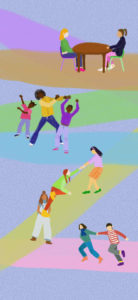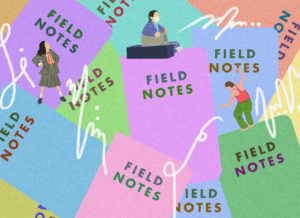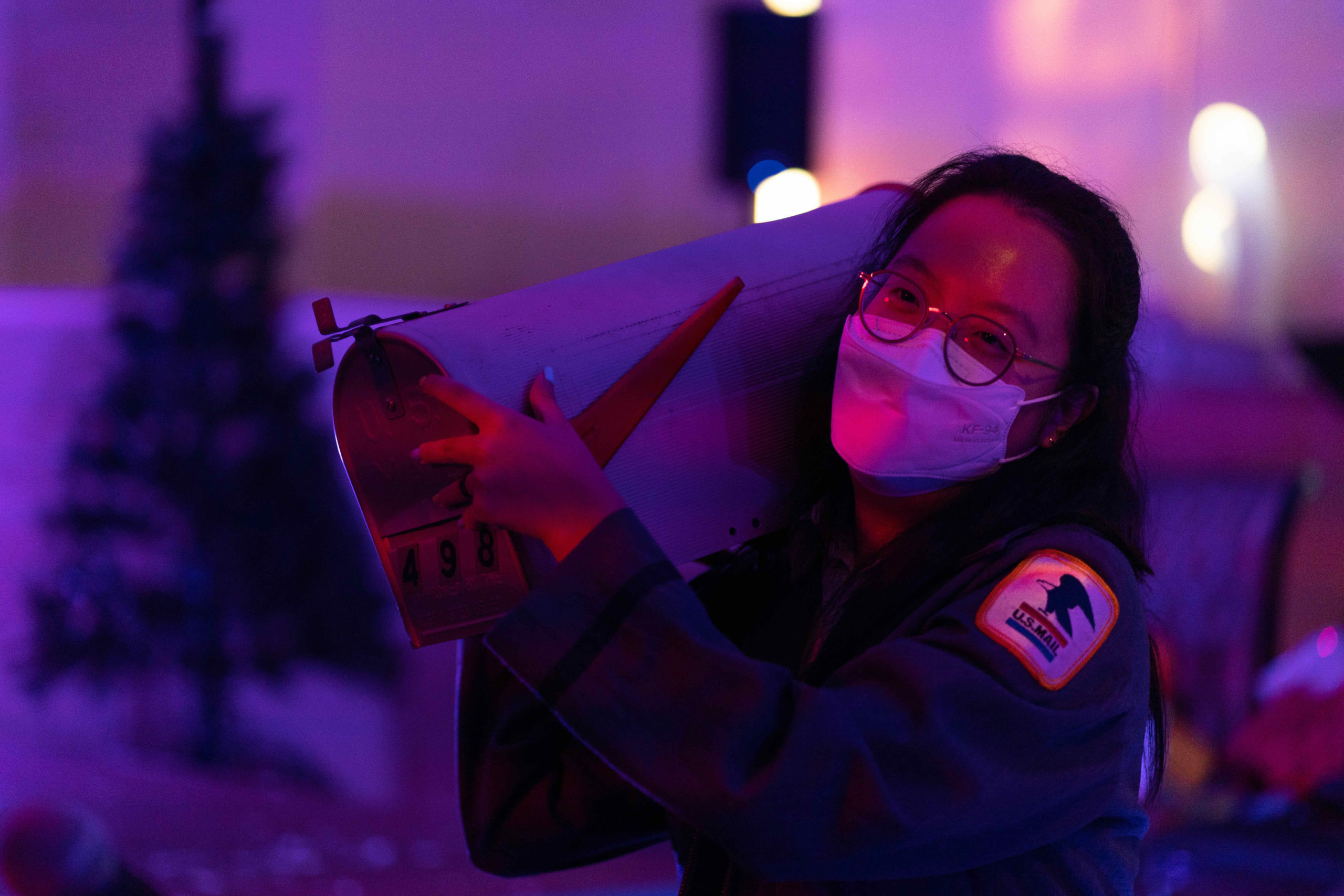Photo by Joe Sofranko
[ID: Haley Baek in a postal worker uniform, glasses, and a white mask. Haley is carrying a mailbox on her shoulder, with its flag down, looking delighted. In the background is a faint silhouette of a small Christmas tree. Pink, blue, and purple wash lights are on.]
When I tell people I study performance as an anthropology major at college, many consider the two an odd mix. However, I’ve always found the two fields to be very similar to one another. For one thing, both of them have some sort of live interaction at their core. Anthropology, roughly defined as a study of human societies and cultures, takes “fieldwork” as the primary method of data collection. Anthropologists immerse themselves in a certain field, interacting with what is happening and conducting interviews. This means that research is often all about building connections with people and places. Similarly, performers and artists are not only in conversation with their audience as they perform, but they are also inspired by all sorts of people and things that surround them in the process of creating. Both fields also constantly ask questions speculating on human life. The theatrical concern of how we can stay connected through art ties gracefully into the anthropological interest of what it means for us to “live together” in this world. I fall in love with the lush humanness of it all every time.
What has largely contributed to my adoration for anthropology and performance recently though, are the moments of unscripted surprise that often happen within meticulous “choreography.” For me, those unexpected encounters almost feel like the most important part of research or a production.

[ID: (Digital drawing) On a baby blue background are thick rainbow colored stripes. In front of them are, from top to bottom, two women at a table looking at each other, one mother and two children dancing with arms up, two girls helping another girl up a ramp, two teens running away holding hands.]
Before I begin any ethnographic research, I spend a lot of time building a detailed plan. I read piles of articles and books related to my theme of research and think about specific events I want to check out, or people that I might want to talk to. I also scrutinize every detail on the internet about my interviewees and write out lists of questions in the order I want to ask them in. While this step of the research is indeed critical to lay the foreground of the forthcoming process, when I actually sit down with my interviewee, much of what I had prepared recedes to the background as the real-time interaction unfolds. Even if I start off with a simple, “Please tell me your name and age” question, sometimes they jump into a twenty minute long story about their failed relationship. But, such surprises take different forms, too. One time, an interviewee generously shared a traumatic experience similar to one I had, allowing both of us to talk it through together and seek ways to keep our lives going. Another time, I was at a memorial gathering and coincidentally encountered a psychologist who I’ve been following on Twitter for years. We had a long, inspiring conversation about queer death, loss and mourning, which not only helped me narrow down my research, but also healed me.
For me, the most constructive learnings, whether or not they are related to my research, come much more from unpredicted events rather than the intense preparation. I’ve had my predictions based on books shattered multiple times as I started the actual fieldwork. I’ve also had days where I learned nothing that would help me write my paper, but still collected precious pieces of wisdom that were and are up to this day, helpful to me as a person. Even though I step into the field as a researcher, these occasions let me recognize myself as a fellow human. I’m not trying to find evidence for my claim and build up my own intellect, but I am engaging in a real, moving, live world. I genuinely want to see, to listen, and to connect.
Studying theater and performance feels like having the same epiphany but just in a parallel universe. I know how much preparation goes into building a show. Thorough devising and intense rehearsal is usually what is behind breathtaking productions. But as much as I respect and enjoy the rigor of that groundwork, I love how live performances, with so many variables, tend to shift shapes when they leave the rehearsal room. For instance, I had to design a rigged bingo game for a show to make everybody win at the same time. Playing the game in rehearsals with a few others to make sure the system worked, I felt like it lacked energy and I got bored. Then, on opening night, when I saw the entire theater shooting their hands up in the air and exploding into joy, I suddenly found the bingo game to be bursting with life. Another time I was playing the role of a postal carrier. During a performance I realized mid-path that no one was sitting in the area I was supposed to deliver the letter to. I’d be lying if I said I wasn’t in a bit of a frenzy. But when I finally arrived to meet eyes with an actual person, not an imaginary audience member in an empty chair, it felt like the moment was swept into a deeper realm than I could reach when I was rehearsing. These moments feel precarious and vulnerable, but they become beautiful because of that.
When talking about precarity and vulnerability, I should mention that I started college at the beginning of the pandemic, and have been juggling even more changes. To have rehearsals and performances canceled last minute and to see companies making the difficult decision to shut down was so disheartening. Yet, at the same time, I still enjoy the new adventures this unprecedented crisis brings into my life. Most recently, I flew to Ashland, Oregon from Seoul, South Korea to make a show. I worked on it for a month and then had to accept the fact that the five-day sold out show was being canceled for safety reasons. However, the private showing that was presented to just a handful of special guests felt so intimate and precious that I couldn’t wish for anything better. Similarly, the actors that I interviewed two years ago for my research on pandemic theater told me that while they were grieving the closure of theaters, they were also finding joy in exploring online meeting platforms as possible stages for their new play.

[ID: (Digital drawing) A colorful array of notebooks saying “field notes” are scattered in the background. From left to right, a girl in a gray school uniform, a postal worker in braids sitting next to a mailbox, and a dancer with arms open and left leg slightly bent are positioned on the notebooks.]
Anthropologist Tim Ingold writes, “To study anthropology is to study with people, not to make studies of them.” The simple sentence implies different things; anthropologists need to build relationships and not extract; they need to pay attention and actually listen to what people say; they should take responsibility for the stories that are shared. But at the crux of the argument is the idea that people are not static objects of investigation, but rather, are unique, complex, and shifting individuals. The kinds of theater work that I’m drawn to are mostly the ones that actively create “with” people, welcoming unexpected encounters. Productions that invite community members into the creative team, or shows that allow children to make as much noise as they want, or even just directors and choreographers who fully trust the performers and their impulses. I still believe preparation allows improvisation to flourish. If we are not ready to be responsible and attentive, the exchange “with” others can easily become exploitative. But the willingness and vulnerability of the efforts within this commitment is what I will always celebrate. And performance makers who are eager to constantly be impacted by others and thus choose to stay open and curious feel the closest to my hometown of anthropology.
This article appeared in the Fall 2022 issue of In Dance.


